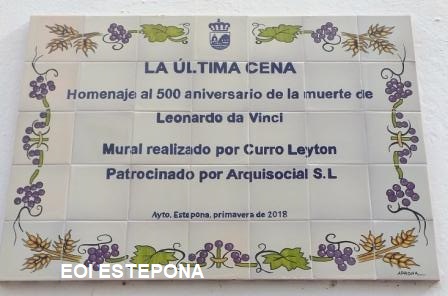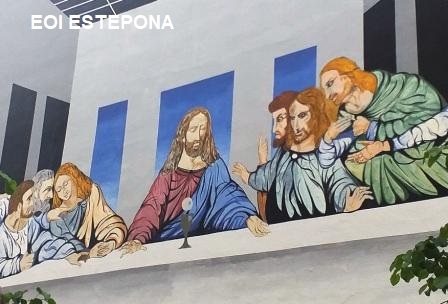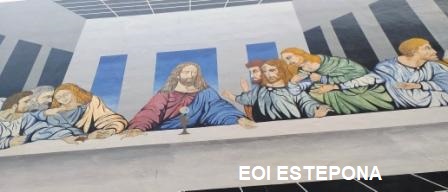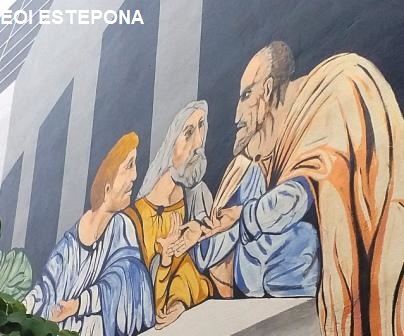LA ÚLTIMA CENA de Curro Leyton. C/ Madrid (Iglesia San José).
La Última Cena
Puri Ríos García B2.2

Estepona’s Town Hall wanted to commemorate the 500th anniversary of the death of the versatile Leonardo Da Vinci with this mural,which reinterpretsThe Last Supper, one of the most emblematic paintings of the Italian Renaissance.The mural was painted by Curro Leyton, an artist from Malaga with a very large career and a lot of experience with murals.
Because of the religious character of the painting, the chosen location for the muralwas the rear facade of the San José church, located on Madrid Street, in the centre of Estepona.
As for the painting itself, we can see a quite unique representation of The Last Supper, since there is a stark contrast between both works. That is, the characters and their placement are quite faithful to the original work, but the environment is not. For instance, the building where Jesus and his disciples arein the mural is markedly contemporary and minimalist.
Another peculiarity that surprises me is the chromatic difference that exists between the characters and the rest of the painting. On the one hand, the characters are usingvery colourful clothing. On the other hand, by contrast, the environment is monochromatic: black, grey and white.
Last but not least, what attracts me most about the mural is the magnificent perspective that the painter has achieved.

La Última Cena
María Salomé Gómez Cabrera B2.2
Right on the rear facade of San José Church, in Madrid Street, The Last Supper, a mural created by Curro Leyton in June 2018, can be found. This artist, who is from Málaga, represented Spain in the Hispanic Parade in New York and has also painted other ones in the Artistic Murals Route of Estepona.
This wall painting is a larger contemporary interpretation of Leonardo Da Vinci’s magnificent masterpiece. The scene represents the moment when Jesus, in the middle of the paintwork, announced to his disciples that he was going to be betrayed by one of them, and each of the disciples’ reactions to this announcement.
Regarding drawing techniques, linear perspective has been used to give depth to this work. So, in the background, we can see three big windows through which the light enters and illuminates the scene, all illustrated through the use of minimalist architecture and plain colours such as white, black, and grey. However, in the foreground, the thirteen characters are portrayed around a table, wearing bright-coloured clothes. This contrast has been employed by the artist in order to highlight these characters.
In my humble opinion, this colourful piece of street art is an eye-catching mural that perfectly matches the renovated modern style of the church.

La Última Cena
Verónica Garre Fernández B2.2
This mural is a version of ‘The Last Supper’ reproduced by Curro Leyton on the rear facade of the San José parish, which, due to the religiousmeaning of the image, makes a lot of sense.
‘The Last Supper’ (Il Cenacolo) is a wall painting made between 1495 and 1498 by the multifaceted Leonardo da Vinci. It was commissioned by Ludovico Sforza for the refectory of the Convent of Santa Maria delle Grazie in Milan, Italy. The scene recreates the last meal between Jesus and his apostles. It is one of the best known paintings of the Italian Renaissance.
In comparison to the original, in this one, the author Curro Leyton has reflected his own style, giving it a more contemporary and minimalist touch through the use of perspective and the play of colours.
With this addition to the Route of Murals, the City Council of Estepona wanted to pay homage to the figure of the genius Leonardo Da Vinci.
From my point of view, the painting conveys the idea of the original but perhaps from a less dramatic perspective than the one the original painting has, such as the betrayal of one of the apostles and how this betrayal is reflected in the expressions of confusion, and even anger, of each one of them.
This mural gives a different atmosphere to the neighbourhood, since you don’t expect to find something like this in a small street in a town, and it’s a good way to attract tourists interested in art or people who are believers and want to enjoy this piece of art.
La Última Cena

Yolanda Parrado Rodríguez B2.2
The famous The Last Supper has arrived in Estepona thanks to Curro Leyton. The local council drove an initiative in 2012 to turn this town into a true open-air museum. Leyton’s giant mural is one of his five worksthat have been incorporated into the Route of Artistic Murals.
The painting is on the southern face of San José Church, near Antonia Guerrero Square in the centre of the old town.
The artist has made his particular interpretation of one of the masterpieces in the history of art. The mural, as the original work, represents the scene of the last supper of Jesus with the twelve apostles, particularly the moment after Jesus tells them that one of them would give him away and the reaction that each apostle had when they heard that. Using the same perspective and composition, the author makes a much more contemporary and minimalist version, only including colour and details in the faces, hands, and clothes of the figures. The rest of the area is black and white.
Personally, I think that Leyton has made a brave and risky work because doing this kind of version may always turn out controversial. As with Da Vinci’s one, you could stand looking at it for ages.
